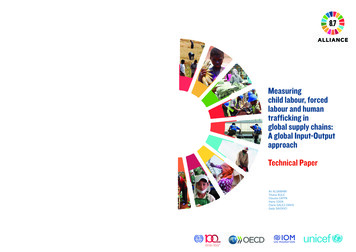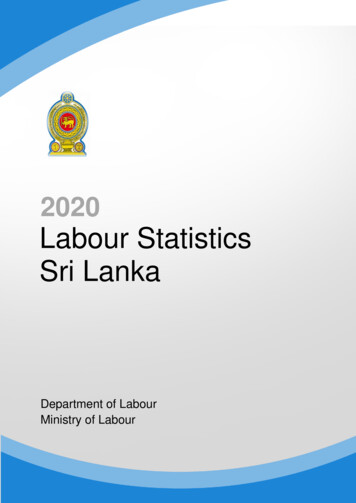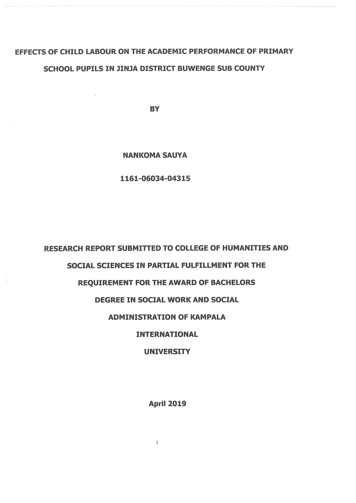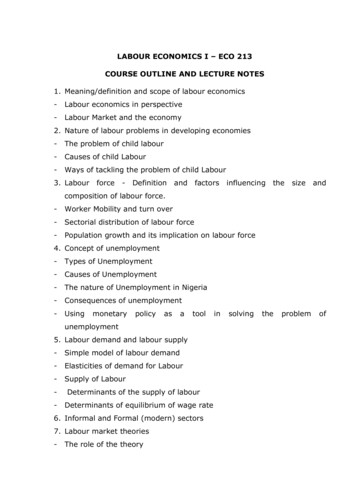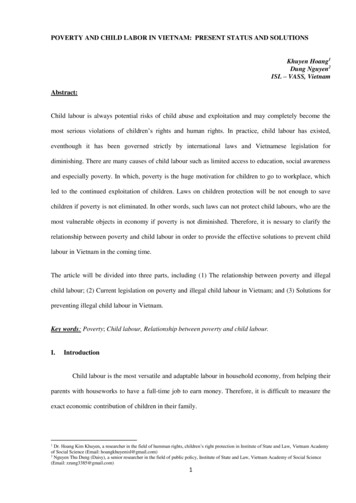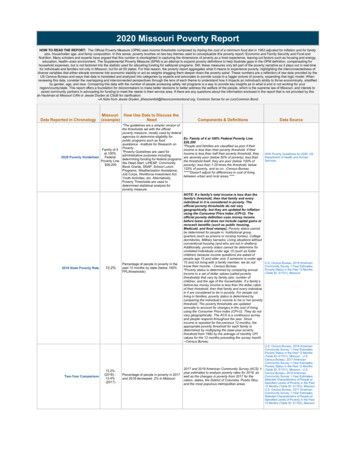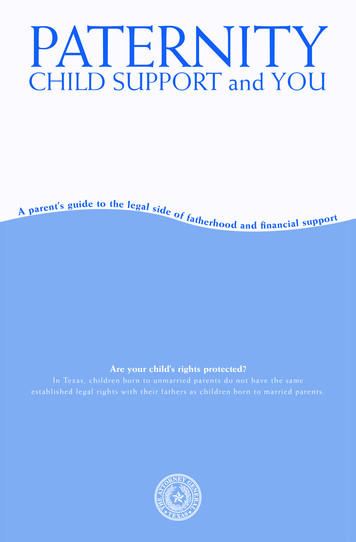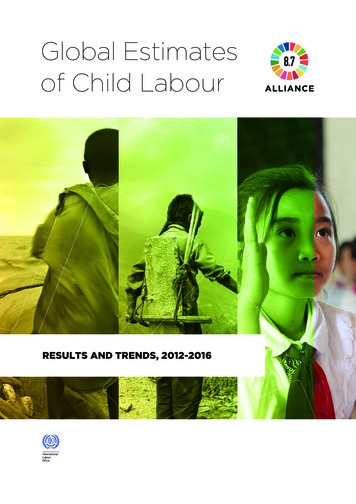
Transcription
Global Estimatesof Child LabourRESULTS AND TRENDS, 2012-2016
Global estimates ofchild labour:Results and trends,2012-2016GENEVA, 2017
Copyright International Labour Organization 2017First published 2017This is an open access work distributed under the Creative Commons Attribution 3.0 IGO License (http://creativecommons.org/licenses/by/3.0/igo). Users can reuse, share, adapt and build upon the original work,even for commercial purposes, as detailed in the License. The International Labour Office (ILO) must be clearlycredited as the owner of the original work. The use of the emblem of the ILO is not permitted in connection withusers’ work.Translations – In case of a translation of this work, the following disclaimer must be added along with theattribution: This translation was not created by the International Labour Office (ILO) and should not beconsidered an official ILO translation. The ILO is not responsible for the content or accuracy of this translation.Adaptations – In case of an adaptation of this work, the following disclaimer must be added along with theattribution: This is an adaptation of an original work by the International Labour Office (ILO). Responsibility forthe views and opinions expressed in the adaptation rests solely with the author or authors of the adaptation andare not endorsed by the ILO.All queries on rights and licensing should be addressed to ILO Publications (Rights and Licensing), CH-1211Geneva 22, Switzerland, or by email to rights@ilo.org.Global estimates of child labour: Results and trends, 2012-2016International Labour Office (ILO), Geneva, 2017ISBN: 978-92-2-130152-3 (print)ISBN: 978-92-2-130153-0 (web pdf)Also available in French: Estimations mondiales du travail des enfants: résultats et tendances 2012-2016ISBN 978-92-2-230938-2 (print); ISBN 978-92-2-230946-7 (web pdf), ILO, Geneva, 2017; and in Spanish:Estimaciones mundiales sobre el trabajo infantil: Resultados y tendencias 2012-2016, ISBN 978-92-2-331046-2(print); ISBN 978-92-2-331047-9 (web pdf), ILO, Geneva, 2017.The designations employed in ILO publications, which are in conformity with United Nations practice, and thepresentation of material therein do not imply the expression of any opinion whatsoever on the part of theInternational Labour Office concerning the legal status of any country, area or territory or of its authorities, orconcerning the delimitation of its frontiers.The responsibility for opinions expressed in signed articles, studies and other contributions rests solely with theirauthors, and publication does not constitute an endorsement by the International Labour Office of the opinionsexpressed in them.Reference to names of firms and commercial products and processes does not imply their endorsement by theInternational Labour Office, and any failure to mention a particular firm, commercial product or process is nota sign of disapproval.Information on ILO publications and digital products can be found at: www.ilo.org/publns.Funding for this report was provided by the United States Department of Labor under Cooperative Agreementnumbers GLO/10/55/USA and GLO/11/11/USA. This report does not necessarily reflect the views or policies of theUnited States Department of Labor, nor does mention of trade names, commercial products, or organizationsimply endorsement by the United States Government.4Global estimates of child labour: Results and trends, 2012-2016
On any given day in 2016children aged 5-17 yearsMETRICS152 152 million were in child labour Of which, 73 million were in hazardous workmillion73millionREGIONAL PREVALENCE OF CHILD LABOUR AfricaAmericasArab StatesAsia and the PacificEurope and Central Asia19.6%5.3%2.9%7.4%4.1%OF THE 152 MILLION CHILDREN IN CHILD LABOURAGE PROFILE48%28%24%GENDER70.9%Agriculture5-11 years-olds12-14 years-olds15-17 years-oldsECONOMIC ACTIVITY58%88 million42%64 million11.9%Industry17.2%Services5
Lisa Kristine
Table of contentsExecutive summary11Introduction19Part 1. Global estimates and trends231.1Main results of the global estimates231.2The regional picture281.3 Child labour and national income321.4 Child labour characteristics: economic sector and work status341.5Age profile381.6 Gender profile421.744Involvement in household chores1.8 Child labour and educationPart 2. Road forward to 20252.1Building a policy response4751522.2 Age, gender, and regional considerations542.3 Building the knowledge base552.4 International cooperation and partnership56Annex: Methodology59Endnotes65Contents7
Lisa Kristine
Table 1Global estimates results at a glanceChildren inemploymentNumber (000s)World(5–17 years)Prevalence (%)5–14 yearsAge range15–17 yearsSex(5–17 years)MaleFemaleAfricaAmericasRegion(5–17 years)Asia andthe PacificEurope andCentral AsiaArab StatesNumber (000s)Prevalence (%)Number (000s)Prevalence (%)Number (000s)Prevalence (%)Number (000s)Prevalence (%)Number (000s)Of which: Childrenin child labourOf which: Children inhazardous work201220162012201620122016264 427218 019167 956151 62285 34472 52516.713.810.69.65.44.6144 066130 364120 453114 47237 84135 37611.810.69.99.33.12.9120 36287 65547 50337 14947 50337 14933.024.913.010.513.010.5148 327123 19099 76687 52155 04844 77418.115.012.210.76.75.5116 10094 82968 19064 10030 29627 75115.212.48.98.44.03.6--99 417--72 113--31 538Prevalence (%)--27.1--19.6--8.6Number (000s)--17 725--10 735--6 553Prevalence (%)Number (000s)Prevalence (%)Number (000s)--8.8--5.3--3.2129 35890 23677 72362 07733 86028 46915.510.79.37.44.13.4--8 773--5 534--5 349Prevalence (%)--6.5--4.1--4.0Number (000s)--1 868--1 162--616Prevalence (%)--4.6--2.9--1.59
Lisa Kristine
ExecutivesummaryThe Sustainable Development Goals include a renewed global commitmentto ending child labour. Specifically, target 8.7 of the Sustainable DevelopmentGoals calls on the global community to:Take immediate and effectivemeasures to eradicate forcedlabour, end modern slavery andhuman trafficking and secure theprohibition and elimination of theworst forms of child labour, including recruitment and use of childsoldiers, and by 2025 end childlabour in all its forms.The current report, the fifth edition of theILO’s quadrennial report series on global estimates of child labour, charts howfar we have come and how far we stillhave to go to honour this commitmentto ending child labour. The report describes the scale and key characteristicsof child labour in the world today, as wellas changes in the global child labour situation over time. It also discusses key policy priorities in the campaign to reach the2025 target. The report, and the globalestimation exercise that underpins it,form part of a broader inter-agency effort under Alliance 8.7 to measure andmonitor progress towards target 8.7 ofthe Sustainable Development Goals.The 2016 estimates tell a story both ofreal progress and of a job unfinished.They show a dramatic decline in childlabour over the 16 years since the ILObegan monitoring child labour in 2000.But the estimates also indicate that thepace of decline has slowed considerablyin the last four years, precisely at a timewhen substantial acceleration is neededto reach the ambitious 2025 target dateExecutive summaryfor ending child labour. The bottom lineis that we remain far from the world wewant: 152 million children are still engaged in child labour, almost half them inits worst forms.Global figuresThe challenge of ending child labour remains formidable. A total of 152 millionchildren – 64 million girls and 88 millionboys – are in child labour globally, accounting for almost one in ten of all children worldwide. Nearly half of all those inchild labour – 73 million children in absolute terms – are in hazardous work thatdirectly endangers their health, safety,and moral development. Children in employment, a broader measure comprisingboth child labour and permitted forms ofemployment involving children of legalworking age, number 218 million.The dynamic picture indicates that weare moving in the right direction. Childlabour declined during the period from2012 to 2016, continuing a trend seensince the publication of the ILO’s firstglobal estimates of child labour in 2000.The 16-year period starting in 2000 sawa net reduction of 94 million in childrenin child labour. The number of childrenin hazardous work fell by more thanhalf over the same period. There werealmost 134 million fewer children in employment in 2016 than in 2000. Realadvances have been made in the fightagainst child labour, providing an important foundation for efforts movingforward.11
But progress slowed during 2012 to2016. A narrower focus on the most recent four-year period indicates a significant slowing down of progress. The reduction in the number of children in childlabour amounted to 16 million for the 2012to 2016 period, just one third of the 47million reduction recorded during 2008to 2012. Expressed in relative terms, theshare of children in child labour fell byonly one percentage point during 2012to 2016 compared to three percentagepoints in the previous four-year period.The decline in hazardous work slowed ina similar fashion.We must move much faster if we are tohonour our commitment to ending childlabour in all its forms by 2025. A simple projection of future progress basedon the pace of progress achieved during2012 to 2016 – the business-as-usual scenario – would leave 121 million childrenstill in child labour in 2025, of which 52million would be in hazardous work. Asimilar calculation indicates that evenmaintaining the pace achieved during2008 to 2012 – the fastest recorded todate – would not be nearly enough. Weare moving in the right direction, but wewill need to move much more quickly toreach zero by 2025.Regional figuresThe Africa region and the Asia and thePacific region together host nine out ofevery ten children in child labour. Africaranks highest both in the percentage ofchildren in child labour – one-fifth – andthe absolute number of children in childlabour – 72 million. Asia and the Pacific ranks second highest in both thesemeasures – 7 per cent of all children, 62million in absolute terms, are in child labour in this region. The remaining childlabour population is divided among theAmericas (11 million), Europe and Central Asia (6 million), and the Arab States(1 million).A breakthrough in Africa will be criticalto ending child labour worldwide. The2016 estimates suggest that sub-SaharanAfrica, the regional grouping for which12we have comparable estimates for 2012,witnessed a rise in child labour duringthe 2012 to 2016 period, in contrast tothe other major regions where child labour continued to decline, and despitethe number of targeted policies implemented by African governments to combat child labour. It is likely that the retrogression was driven in important partby broader economic and demographicforces acting against governmental efforts, although this is a matter requiringfurther research.There is a strong correlation betweenchild labour and situations of conflictand disaster. The Africa region has alsobeen among those most affected by situations of conflict and disaster, which inturn heighten the risk of child labour. Theincidence of child labour in countries affected by armed conflict is 77 per centhigher than the global average, whilethe incidence of hazardous work is 50per cent higher in countries affectedby armed conflict than in the world asa whole. This situation underscores theimportance of prioritizing child labourwithin humanitarian responses and during reconstruction and recovery; governments, workers’ and employers’ organizations, and humanitarian actors all havea critical role to play in this context.Characteristics ofchild labourThe agricultural sector accounts for byfar the largest share of child labour.The sector accounts for 71 per cent of allthose in child labour and for 108 millionchildren in absolute terms. Child labourin agriculture relates primarily to subsistence and commercial farming and livestock herding. It is often hazardous in itsnature and in the circumstances in whichit is carried out. Children in child labour inthe services and industry sectors number26 million and 18 million, respectively, butthese sectors are likely to become morerelevant in some regions in the future inthe face of forces such as climate changedisplacing families from their farms andinto cities.Global estimates of child labour: Results and trends, 2012-2016
Most child labour takes place within thefamily unit. More than two-thirds of allchildren in child labour work as contributing family labourers, while paid employment and own-account workers make up27 per cent and 4 per cent, respectively,of those in child labour. These numbersunderscore an important broader pointconcerning the nature of child labour inthe world today. Most children in childlabour are not in an employment relationship with a third-party employer, butrather work on family farms and in familyenterprises; understanding and addressing family reliance on children’s labourwill therefore be critical to broader progress towards ending child labour.Forced labour of children requires special attention. According to the 2016Global Estimates of Modern Slavery,1there were about 4.3 million childrenaged below 18 years in forced labour,representing 18 per cent of the 24.8 million total forced labour victims worldwide. This estimate includes 1.0 millionchildren in commerical sexual exploitation, 3.0 million children in forced labourfor other forms of labour exploitation,and 300,000 children in forced labourimposed by state authorities. This extreme form of child labour, in which thechildren suffer both the impact of thehazardous working conditions and thetrauma of coercion, threats of penalty,and lack of freedom, require urgent action from governments and the international community.Other key resultsCHILD LABOURAND NATIONAL INCOMEChild labour is most prevalent inlow-income countries but it is by nomeans only a low-income countryproblem. The prevalence of child labouris highest in the low-income countries,at 19 per cent. By comparison, 9 percent of children in lower-middle-incomecountries, 7 per cent of children in upper-middle-income countries, and 1 percent of children in upper-income countries are in child labour. But expressedExecutive summaryin absolute terms, 84 million childrenin child labour, accounting for 56 percent of all those in child labour, actuallylive in middle-income countries, and anadditional 2 million live in high-incomecountries. These statistics make clearthat while poorer countries will requirespecial attention, the fight against childlabour will not be won by focusing onpoorer countries alone.AGE PROFILE OF CHILD LABOURChildren aged 5 to 11 years form thelargest share of those in child labour andalso form a substantial share of those inhazardous work. Forty-eight per centof all those in child labour are in the 5–11years age bracket, 28 per cent are aged12–14 years, and 25 per cent fall into the15–17 years age range. Younger childrenconstitute a smaller but still substantial share of total children in hazardouswork. A quarter of all children in the hazardous work group – 19 million childrenin absolute terms – are aged 5-11 years.While there are no possible exceptionsfor hazardous work – all children must beprotected from hazardous child labour –the group of very young children facinghazardous work conditions directly endangering their health, safety, and moraldevelopment is of special concern.There are still substantial numbers ofchildren in child labour who are abovethe minimum working age. Recent progress has been fastest among childrenaged 15–17 years, but there are almost38 million children – 24 million boys and14 million girls – in this age range in childlabour. It should be recalled that 15-17year-olds are above the minimum working age and therefore are not countedas child labourers because they are tooyoung. Rather, they are in child labourbecause their work is or may be physically or psychologically injurious to theirhealth and well-being. This basic fact isreinforced by country-level statistics indicating that 15-17 year-olds in child labour suffer higher levels of work-relatedillness and injury than other employedchildren in this age range. They are alsomore likely than other employed 15-17year-olds to have dropped out of schoolprematurely.13
GENDER PROFILE OF CHILD LABOURBoys appear to face a greater risk ofchild labour than girls. There are 23 million more boys than girls in child labourand 17 million more boys than girls in hazardous work. The gender gap increaseswith age. The difference in child labourincidence is less than one percentagepoint for 5–11 year-olds, rising to threepercentage points for 12–14 year-olds andto five percentage points for 15–17 yearolds. But it is possible that these figuresunderstate girls’ work relative to that ofboys. As pointed out in previous global reports, girls may be more present inless visible and therefore under-reportedforms of child labour such as domesticservice in private households. It is alsoworth noting that the decline in childlabour among girls was only half thatamong boys during the 2012 to 2016period, meaning that the gender gap inchild labour has narrowed.Girls are much more likely than boys toshoulder responsibility for householdchores, a form of work not consideredin the child labour estimates. Estimatesof children’s involvement in householdchores, produced for the first time forthe 2016 Global Estimates, indicatesgirls are much more likely than boysto perform household chores in everyweekly hour bracket. Girls account fortwo-thirds of the 54 million childrenaged 5–14 years who perform householdchores for at least 21 hours per week, thethreshold beyond which initial researchsuggests household chores begin tonegatively impact on the ability of children to attend and benefit from school.Girls account for a similar share of the29 million children aged 5-14 years performing chores beyond a threshold of28 hours per week, and of the nearly7 million performing chores for 43 ormore hours each week. Girls are alsomore likely than boys to perform “double work duty”, meaning both work inemployment and in household chores.CHILD LABOUR AND EDUCATIONChild labour is frequently associatedwith educational marginalization. The2016 Global Estimates are also the first to14address the relationship between schooling and child labour, in turn one of themost important determinants of the impact of child labour on decent work andsustainable livelihood prospects later inthe life cycle. The estimates indicate thata very large number of children in childlabour are completely deprived of education – for the 5–14 years age group, thereare 36 million children in child labour whoare out of school, 32 per cent of all thosein child labour in this age range. While theremaining 68 per cent are able to attendschool, a growing body of research suggests that these children too are penalized educationally for their involvementin child labour. The time and energy required by work interfere with children’sability to derive educational benefit fromtheir time in the classroom and to findtime outside the classroom for independent study. As a result, children in child labour tend to perform relatively poorly interms of learning achievement and to lagbehind their non-working peers in termsof grade progression.Data sources andmethodologyThe 2016 estimates use data from a total of 105 national household surveyscovering more than 70 per cent of theworld population of children aged 5 to17 years. All world regions are covered,and data from the Organization for Economic Cooperation and Development(OECD) countries and China are included for the first time. The ILO gratefullyacknowledges the contributions of numerous national statistical offices, andof the United Nations Children’s Fund(UNICEF), the demographic and healthsurveys programme of United StatesAgency for International Development(USAID), and the Statistical Office of theEuropean Union (Eurostat) in facilitatingaccess to the data utilised. The UnitedStates Department of Labor providedimportant financial support to the ILO’sstatistical work on child labour. The 2016estimates are based on the extrapolation of data from the surveys following aGlobal estimates of child labour: Results and trends, 2012-2016
similar methodology as that used for the2000, 2004, 2008, and 2012 estimates.The methodology and data used in producing the 2016 Global Estimates aresummarized in Appendix 1 of this reportand are discussed in greater detail in thecompanion technical paper: Methodology of the global estimates of child labour,2012-2016.Conclusions andway forwardHow do we get from where we are nowto where we want to be by 2025? Thanksto a growing body of practical experience, research, and impact evaluations,we know a fair deal about the broadstrategies and policies that are of mostrelevance in the fight against child labour.Policy responses to child labour needto be integrated into broader nationaldevelopment efforts and adapted to local circumstances. We know that childlabour is the product of an array of economic and social forces, and attemptingto address it without consideration ofthese forces is therefore unlikely to besuccessful. This means, above all, mainstreaming child labour into broader social development policies, rather thantreating it as an isolated issue. Ensuringthat child labour concerns are reflectedin broader policies in the areas of education, social protection, labour marketsand labour standards is especially relevant to progress against child labour.We also know from experience thatthere is no one-size-fits-all approach toaddressing child labour. Rather, strategic responses need to be tailored tothe variety of contexts in which child labour persists. This includes contexts ofstate fragility and armed conflict, wherea large share of children in child labourlive. It also includes contexts affected byforces such as climate change, economicinformality, urbanization, and globalization, each of which presents special challenges in terms of protecting childrenfrom child labour.Executive summaryPolicy responses should also addressthe age, gender and regional dimensions of child labour. Just under half ofall those in child labour are below 12 yearsof age and continued attention to theseespecially vulnerable children is therefore essential, particularly in light of theapparent stagnation in progress for thisgroup over the last four years. Renewedattention must also be paid to 15–17 yearolds in child labour. This group is relevantto the fields of child labour, youth employment, and occupational safety andhealth, but has hitherto rarely been accorded priority in any of them. This mustchange. Differences between boys andgirls in terms of the extent and nature oftheir involvement in child labour underscore the continuing relevance of policymeasures that address the role of gender in determining whether children aresent to work and the risks they face oncethere. The results indicating that girlsshoulder disproportionate responsibilityfor household chores also raise important gender concerns that merit consideration in child labour policies. In regionalterms, Africa, where child labour is highest in both proportionate and absoluteterms, and where progress has stalled,remains a particular priority.Continued investment in building theknowledge base on child labour is needed to inform policy responses. There isan ongoing need for information aboutthe impact of policies and interventionson child labour. With the exception ofcash transfers, still too little is knownabout the effectiveness of interventionsin policy areas of relevance to child labour, which, in turn, is impeding policydevelopment. There is a general need formore knowledge of the implications forchild labour of broader global challenges, including climate change, migration,inequality, urbanization, and changes inthe world of work. We also need to knowmore about how child labour is linked toother violations of fundamental labourrights. The effective targeting of policieswill require better information on childrenin the worst forms of child labour otherthan hazardous work, building on the research and methodological work alreadyundertaken by the ILO and other bodies.15
International cooperation and partnership will also be critical to progress.Alliance 8.7 has a key role to play in supporting governments in efforts towardsending child labour by the 2025 targetdate. The Alliance focuses on accelerating action, conducting research andsharing knowledge, driving innovation,and increasing and leveraging resources. It brings together all actors, includingthe critically important social partners –workers’ and employers’ organizations– as well as civil society organizations.In many countries, the cost of requiredaction far exceeds available governmentresources, meaning that internationalresource mobilization will also be imperative to success against child labour,within the spirit of Article 8 of ILO WorstForms of Child Labour Convention, 1999(No. 182). The returns on the investmentin ending child labour are incalculable.Children who are free from the burden ofchild labour are able to fully realize theirrights to education, leisure, and healthydevelopment, in turn providing the essential foundation for broader social andeconomic development, poverty eradication, and human rights.16Global estimates of child labour: Results and trends, 2012-2016
Lisa Kristine
IntroductionSome things are just wrong. Child labouris a brake on sustainable developmentand anathema to just societies, and itseradication must be pursued with utmost determination. The eradication ofchild labour is a matter of human rights,with an institutional umbrella providedby two fundamental International LabourOrganization (ILO) Conventions, theMinimum Age Convention, 1973 (No. 138)and the Worst Forms of Child LabourConvention, 1999 (No. 182), as well as bythe United Nations (UN) Convention onthe Rights of the Child. These Conventions emphasize that freedom from childlabour is a human right and that the elimination of child labour is a universal andfundamental value.The 2016 Global Estimates present thescale, prevalence, and key characteristicsof child labour in the world today. Childlabour remains endemic and its elimination requires both economic and socialreform as well as the active cooperationof all those active cooperation of governments, workers’ and employers’ organizations, enterprises, international organizations, and civil society at large.In response to persistent and emerging development challenges, the globalcommunity adopted the 2030 Sustainable Development Goals (SDGs). This“2030 Agenda” is a comprehensive,far-reaching, and people-centred set of17 interrelated goals and 169 associatedtargets to guide global development efforts over the coming 13 years. The Sustainable Development Goals include arenewed global commitment to endingchild labour. Specifically, target 8.7 of theSustainable Development Goals calls onthe global community to:Take immediate and effectivemeasures to eradicate forcedlabour, end modern slavery andhuman trafficking and secure theIntroductionprohibition and elimination of theworst forms of child labour, including recruitment and use of childsoldiers, and by 2025 end childlabour in all its forms.The current report, the fifth edition ofthe ILO’s quadrennial report series onglobal estimates of child labour, chartshow far we have come and how far westill have to go to honour this commitment to ending child labour. The reportdescribes the scale and key characteristics of child labour in the world today, aswell as changes in the global child laboursituation over time. It also discusses keypolicy priorities in the campaign to reachthe 2025 target. The report, and theglobal estimation exercise that underpinsit, forms part of a broader inter-agencyeffort under Alliance 8.7 (see next section) to measure and monitor progresstowards target 8.7 of the Sustainable Development Goals.As for those produced for 2000, 2004,2008, and 2012, the 2016 estimates arebased on the extrapolation of data fromnational household surveys. The new estimates use data from a total of 105 surveys covering more than 70 per cent ofthe world population of children aged 5to 17 years. All world regions are covered,and data from the Organization for Economic Cooperation and Development(OECD) countries and China are includedfor the first time. The ILO gratefully acknowledges the contributions of numerous national statistical offices, the UnitedNations Children’s Fund (UNICEF), theDemographic and Health Surveys (DHS)programme of the United States Agencyfor International Development (USAID),and the Statistical Office of the European Union (Eurostat) in facilitating accessto the data used to produce the globalestimates. The US Department of Laborprovided important financial support tothe ILO’s statistical work on child labour.19
Thanks to more and richer data from national household surveys and ongoingrefinements in estimation methods, thechild labour profile emerging from the2016 estimates is the most detailed todate. In addition to expanded geographical coverage, these latest estimatesbreak new ground in providing the firstglobal estimates of children’s involvement in household chores and of therelationship between child labour andschooling. The methodology and dataused in producing the global estimatesare summarized in Annex 1 of this reportand are discussed in greater detail in thecompanion technical paper: Methodology of the global estimates of child labour,2012-2016.2A mixed picture emerges from the latest global estimates. Child labour hascontinued to fall but the pace of declinehas slowed considerably in the past fouryears. A simple projection based on thepac
9 Table 1 Global estimates results at a glance Children in employment Of which: Children in child labour Of which: Children in hazardous work 2012 2016 2012 2016 2012 2016
